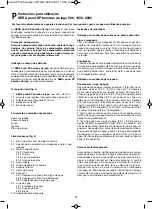
8
The
sera pond pumps SP
convince due to their compact and
robust construction as well as low energy consumption. Pump
shape and performance data have been optimized.
SAFETY PRECAUTION!
Always unplug all electrical devices located in the water
before doing any work on the pump, fountain or pond!
Electrical devices operated in the water should be con-
nected with a circuit breaker (ground fault interrupter).
Application and application range
The
sera pond pumps SP
are particularly well suited for oper-
ating a water display or a brook.
We recommend that you use the somewhat larger
sera pond
pumps PP
for operating pond filters or similar devices that re-
quire permanent water supply.
Kit includes (fig. 1)
1.1
sera pond pump SP
with 10 m (11 yd.) cable
1.2 Adjustable water display with prolongations and T-piece
1.3 Hose connector Ø 19 mm (3/4”)
1.4 Rubber feet
1.5 Fountain jet nozzles
Required accessories
Flat-bladed screwdriver
Philips screwdriver
Gloves
Scissors
Silicon oil
Parts list (fig. 2)
2.1 Motor block with pump chamber
2.2 Connection piece for hose connector and water display
2.3 Impeller unit consisting of
2.3.1 Bearing
2.3.2 Impeller
2.3.3 Ceramic shaft
2.3.4 Magnetic rotor
2.4 Seal ring
2.5 Pump chamber cover
2.6 Filter sponge
2.7 Pump cover
2.8 T-piece
2.8.1 Flow regulator for water display
2.8.2 Flow regulator for branch
2.8.3 Push-in connector for water display
2.9 Water display
2.9.1 Prolongations (2 pieces)
2.9.2 Nozzle holder
2.9.3 Nozzles
2.10 Hose connector
Assembly instruction
Usage as a brook operating pump or as a filter pump
Connecting the hose
The hose connector (2.10) allows connecting hoses with
19 mm (3/4”) internal diameter. Push a hose clamp over the
pond hose. Cut off the hose end vertically. Now push the hose
onto the hose connector and secure the hose with the hose
clamp. You will need a flat-bladed screwdriver to do so.
Location
The pump should not be placed directly on the bottom of the
pond but about 20 cm (8 in.) above the pond bottom, e.g. on a
rock. This avoids the pump taking in sludge and, in particular,
sand which may cause quicker wear and tear.
Usage as a fountain pump
Screwing on the water display nozzle
The T-piece (2.8) with the flow regulators (2.8.1 / 2.8.2) can op-
tionally be integrated. The T-piece is screwed into the outlet
opening of the motor block (2.2), screw thread directed down-
wards.
Assemble the water display (2.9.1 / 2.9.2). You can use both
standpipes (2.9.1) together or just one, just as you like. If you
wish to use the standpipes (2.9.1) without the T-piece (2.8),
screw off the push-in connector (2.8.3) for the water display at
the upper end of the T-piece. Screw the push-in connector
(2.8.3) into the connection piece (2.2) on top of the motor block
and push the standpipe (2.9.1) into the push-in connector.
The pump should be located at least 10 cm (4 in.) below the
water surface as to avoid air being permanently drawn in dur-
ing operation.
The water flow rate for the water display (2.9.1 / 2.9.2) can be
adjusted by turning the flow regulator (2.8.1). However, this
must not be done while in operation. The pump must be
switched off before any adjustment of the water display as to
prevent a possible electric shock. Be sure not to close the flow
regulator (2.8.1) for the water display (2.9) entirely, as the wa-
ter display (2.9) may fly off otherwise.
Operation
Make sure no persons are in the water, and no conducting
parts are connected to the water before switching on the
pump. The pump starts running upon plugging it in. The pump
does not have an additional On/Off switch. The pump is de-
signed for permanent operation but must not run dry as the
motor block is cooled by water and the ceramic bearings are
lubricated by water. Switch off the pump again and check
whether nothing is clogged if no water is delivered after a few
seconds. Switch the pump back on only afterwards.
US
Information for use
sera pond pumps SP 500, 1500, 2000
Please read these instructions carefully and keep for future use.
sera SP Teichpumpen INT GBI 29.04.2010 10:54 Seite 8

























